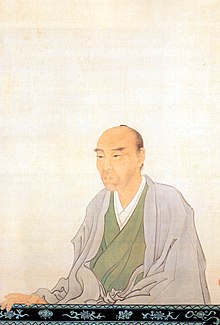Watanabe Kazan

Watanabe Kazan ( Japanese 渡 辺 崋 山 ; * October 20, 1793 in Edo ; † November 23, 1841 ) was a Japanese painter who simultaneously dealt with the administration of his province, with Western science and with questions of national defense at a time that was marked by social and political unrest.
Life
Kazan was born in today's Hayabusachō in the Edo residence of Tahara-han ( Mikawa province , now Aichi prefecture ). His father worked in various functions, finally as head of administration ( toshiyoriyaku ) for the Han. The Han (fiefdom), small with 12,000 koku, was in economic difficulties, which also affected the living conditions of the Watanabe family. Kazan received his first instruction in the teachings of Confucius a . a. by Satō Issai and Matsuzaki Kōdō (1771-1844). In 1819, at the age of 16, he visited his hometown Tahara for the first time. In the same year he began to study painting under Shirakawa Shizan (? –1857?) In Edo, and from the following year Nanga painting under Kaneko Kinryō (? –1817) and Tani Bunchō . In Buncho's studio he later got to know pictures of Shin Nanpin , which he copied.
In 1818 he submitted a memorandum to his prince to improve the administration, after which he stayed briefly in Tahara for the second time. Back in Edo, he was asked to do illustrations for the book Gendō hogen by Kyokutei Bakin . He visited the Okegawa post office north of Edo to make sketches . In 1824 he met the Han doctor, Suzuki Shunzan (1801–1846), who aroused his interest in Rangaku . In March 1826 he met Heinrich Bürger , a member of the Dutch Mission, which regularly visited Edo. In 1827 he replaced the first character of his (artistic) first name 華 , "flower", which he had been using since he was around 20, with the same 崋 , the name of a mountain in China.
The economic situation in the province remained bad. And when the prince was appointed "Commissioner for the celebrations in Nikkō " ( Nikkō sairei bugyō ), the burden on the Han increased further. In 1832 Kazan was appointed head of the Han administration and now also had to take care of the coastal defense. In 1833 he was back in Tahara to take stock. Now Japan was hit by the famine of the Tempō period ( 天保 飢饉 , Tempō no kikin ) 1833-1836. Kazan joined the Shōshikai ( 尚 歯 会 ) called association, which has dealt with social issues since 1836, while being critical of the shogunate. When Kazan had to take over the management of the residence in Edo while the prince was absent, he, physically weakened, submitted a resignation, which was not accepted.
In April 1838 he wrote at the request of Egawa Hidetatsu (1801–1855) writings on national defense. With his writings Gekizatsu wakumon ( 鴃 舌 或 問 ) and Shinkiron ( 慎 機 論 ) he criticized the measures taken by the government against foreign countries besetting Japan. In 1838 he had the opportunity to exchange ideas with the manager of the Dutch station Dejima , JE Niemann.
In 1839 the shogunate, troubled by the Morrison incident , arrested Kazan and his comrades-in- arms Takano Chōei (1804–1850) and Koseki Sanei (1787–1837), they ended up in the so-called "Bansha hell" ( 蛮 社 の 獄 , Bansha no goku ). Through intercession, Kazan was spared the death penalty, but he was expelled from Edo in 1840 and placed under house arrest in Tahara. There he devoted himself entirely to painting and tried to found an association to sell his pictures. When this became known, he committed suicide to spare his prince trouble. He was buried in Tahara in Jōhō-ji, his family's tomb has been preserved.
Picturesque work
Although busy with the administrative duties for his province, Kazan took time to sketch and paint all his life. His early pictures still show the influences of his teachers, with his sensitive portraits he achieved his very own style. Despite the difficult living conditions, he kept a humorous view of his surroundings, as his surviving sketchbooks show. His best-known work is the portrait of Takami Senseki , ( 鷹 見 泉石 , 1785-1858), administrative director ( Karō ) of the Koga-han in the Shimousa province from 1837 ( national treasure ).
Tsubaki Chinzan (1801–1854) is one of his students .
Remarks
- ↑ Also Siebold was in this mission.
- ↑ Note that this portrait only shows the person, not the entire hanging scroll.
literature
- Géza S. Dombrády: Watanabe Kazan. A 19th century Japanese scholar. Hamburg / Tôkyô: OAG 1968. 226 p. (Habilitation thesis)
- Hideo Hibino: Watanabe Kazan (= Shinchō Nihon bijutsu bunko . No. 20 ). Shinchosha, 1997, ISBN 4-10-601540-4 .
- Yutaka Tazawa: Biographical Dictionary of Japanese Art . Kodansha International, 1981, ISBN 0-87011-488-3 .
- Y. Yonezawa, Chu Yoshizawa: Japanese Painting in the Literati Style. The Heibonsha Survey of Japanese Art . Vol. 23. Weatherhill / Heibonsha, 1974, ISBN 0-8348-1019-0 .
Web links
| personal data | |
|---|---|
| SURNAME | Watanabe, Kazan |
| ALTERNATIVE NAMES | 渡 辺 崋 山 (Japanese); Watanabe, Sadayasu |
| BRIEF DESCRIPTION | Japanese painter |
| DATE OF BIRTH | October 20, 1793 |
| PLACE OF BIRTH | Edo , Musashi Province |
| DATE OF DEATH | November 23, 1841 |



